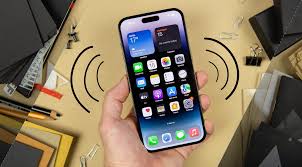Unlock a new dimension of interaction with your iPhone through the subtle but powerful realm of haptics.
Ever wondered how your device communicates with you beyond visuals and sounds? The answer lies in the realm of touch. As you navigate through your phone, each tap, swipe, or press is accompanied by a unique tactile sensation that enhances your user experience.
Curious to discover how this technology revolutionizes the way you engage with your device?
Understanding Haptics Technology
When exploring haptics technology, it’s essential to understand its role in enhancing tactile feedback on devices like the iPhone. Haptics technology focuses on simulating the sense of touch through vibrations, motions, and forces. This technology allows users to feel a response when interacting with their devices, making the experience more engaging and intuitive.
On the iPhone, haptics technology is integrated into the device to provide users with tactile feedback in various situations. For example, when typing on the keyboard, you may feel subtle vibrations that mimic the sensation of pressing physical keys. This feedback helps improve typing accuracy and gives a more satisfying typing experience.
Moreover, haptics technology is used in gaming to create immersive experiences by providing vibrations that correspond to in-game actions. When playing games on your iPhone, you can feel the impact of actions like crashes, explosions, or collisions through haptic feedback, adding another dimension to your gaming experience. Understanding how haptics technology enhances tactile feedback on the iPhone can help you appreciate the nuances of interacting with your device.
Types of Haptic Feedback
Exploring the various types of haptic feedback enhances your understanding of how tactile sensations are simulated on the iPhone. The iPhone employs different types of haptic feedback to provide users with a more immersive and engaging experience.
One common type is the ‘Tap’ feedback, which mimics the sensation of tapping on a physical button. This feedback is often used to confirm selections or interactions on the screen.
Another type is ‘Flutter,’ which creates a rapid vibration pattern, adding a sense of texture to on-screen elements. ‘Press’ feedback is designed to simulate the feeling of pressing down on a physical button, making interactions feel more realistic.
Additionally, the ‘Custom’ feedback allows developers to create unique haptic patterns tailored to specific actions within apps. By incorporating these various types of haptic feedback, the iPhone offers users a more intuitive and interactive experience that goes beyond traditional touchscreens.
Evolution of Haptics on Iphone
The evolution of haptics on the iPhone has transformed the way you interact with your device, revolutionizing the tactile feedback experience. From the early days of simple vibration alerts to the sophisticated Taptic Engine in newer models, Apple has continually refined and improved the haptic technology integrated into its devices.
Initially, haptics on the iPhone were limited to basic vibrations for notifications and alerts. However, with each new iPhone release, advancements in haptic technology have been made. The introduction of the Taptic Engine brought about more nuanced vibrations, allowing for different types of feedback depending on the interaction.
As Apple focused on enhancing user experience, haptics evolved to provide more precise and realistic tactile sensations. This evolution has enabled features like 3D Touch and haptic feedback for various interactions, creating a more immersive and engaging user experience. The evolution of haptics on the iPhone showcases Apple’s commitment to innovation and user-centric design, continually pushing the boundaries of what’s possible in the realm of tactile feedback technology.
Benefits of Haptic Feedback
The enhanced haptic feedback on the iPhone not only elevates the user experience but also offers distinct advantages that enhance the overall interaction with the device.
One of the key benefits of haptic feedback is the improvement in accessibility features. The tactile response provided by haptics allows users with visual impairments to navigate their devices more effectively through touch.
Moreover, haptic feedback enhances the sense of realism in interactions with the device. For instance, when typing on the keyboard, the subtle vibrations simulate the feeling of pressing physical keys, providing a more engaging user experience.
Additionally, haptic feedback can increase productivity by providing subtle notifications and alerts without disrupting the user’s workflow. This feature allows you to stay informed without constantly checking your screen.
Future of Tactile Technology
Advancements in tactile technology are shaping the future of user interactions with devices, promising enhanced sensory experiences and increased engagement. The future of tactile technology holds exciting possibilities, with innovations like more precise haptic feedback, advanced textures, and customizable sensations. Imagine a world where your device’s touchscreen not only responds to your touch but also provides varying levels of resistance, simulating different textures like smooth glass or rough sandpaper.
Furthermore, the integration of haptics into virtual reality (VR) and augmented reality (AR) environments is set to revolutionize how we perceive and interact with digital spaces. Soon, you might feel the weight of virtual objects in your hand or the sensation of walking on different surfaces while immersed in a virtual world. These developments have the potential to make digital experiences more immersive, realistic, and engaging, blurring the lines between the physical and digital realms. As haptic technology continues to evolve, the future holds endless possibilities for creating truly multisensory interactions that can enhance our overall digital experiences.
Conclusion
You’ve now delved into the world of haptics technology on iPhone, experiencing the evolution of tactile feedback and its benefits.
With various types of haptic feedback enhancing user experience, the future of this technology looks promising.
Stay tuned for more advancements in tactile technology that will continue to revolutionize the way we interact with our devices.
Get ready to feel the future in the palm of your hand with haptic feedback on iPhone.
